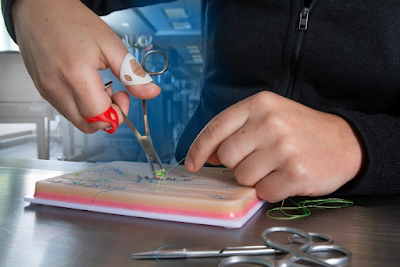Chloe Cottone uses prototype 3D finger braces to help
with her hypermobility issues as she practices using sutures. Photo: Sandra
Kicman
Bill Bruton reported this exciting development in UBNow.
"First-year UB medical student Chloe Cottone had a problem that could have quickly derailed her dream of becoming a surgeon. But a collaboration between the Jacobs School of Medicine and Biomedical Sciences and the School of Engineering and Applied Sciences is keeping that dream alive."
"Cottone deals with Ehlers-Danlos syndrome, a group of
inherited disorders that affects connective tissues — in this case, her joints.
She has hypermobility in her joints, which means she has an unusually large
range of movement and is at risk of injury because her joints are too flexible."
“When I was in gross anatomy lab, I struggled to use
some of the surgical instruments in conventional ways because of the
hypermobility — specifically in my thumbs,” she explains. She tried swan
splints, which can be worn on the fingers or thumb and are designed to block
hyperextension without limiting flexion.
“There are some companies that make metal ones, but they’re
extremely expensive. They were like $100 a pop. And I couldn’t find anything
online that did what I needed and could be used under a surgical glove,”
Cottone says.
"As a medical student without a lot of extra spending money,
she got creative. She went to Michaels, an arts and crafts store, and
bought a ring sizer and some copper wire to make something herself. “They
worked for a little bit. Unfortunately, they ripped through the surgical
gloves,” she says.
"Her gross anatomy instructor, Stuart D. Inglis, instructor
in the Department of Pathology and Anatomical Sciences, saw she was
struggling. “What she was finding was that when she was holding the scalpel,
her fingers would bend in an awkward sort of way and pop out of joint and pop
back in, causing her a great deal of pain,” Inglis says.
The prototypes later developed could be a game-changer.
“Surgeons are very dedicated to their job,” McLaughlin-Kelly notes. "They don’t want to give up the operating room, so they operate right up until they can’t. But if they have braces like this that allow them to work longer — the same with people out in the work force in other occupations — this can help prolong their careers,” she says. “It can also be used as a preventive measure. This can make a huge difference in terms of medicine.”
"Cottone says that what started as a small personal project
is now something that can have a much larger impact. “Now we are thinking of
how we can make these available to other people who work in health care who
have hypermobility, who can’t afford several hundred dollars on metal splints.”
Read more about this at:
Cheers!
Donna


No comments:
Post a Comment